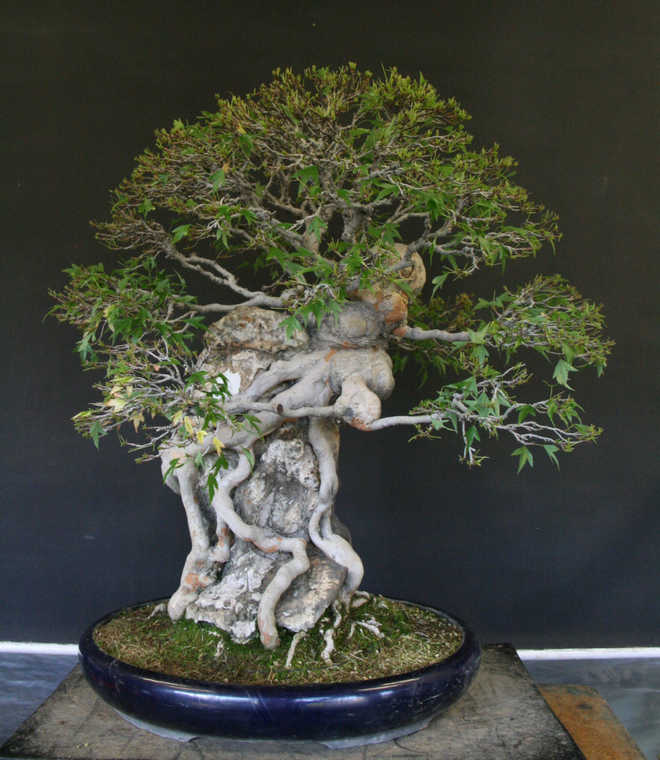Rocking appeal
C S Bewli
Roots-over-rock is one of the most dramatic styles of bonsai, where the roots are deliberately exposed out of the pot and are spread out to cling on to a piece of rock or a stone. This way the stone and the tree appear as a single entity.
This type of union is often witnessed in Nature in rocky and mountainous terrain where during a tree’s growth process the upper roots clench a rock. However, in cultivation, the perfect balance between the two depends how best the ‘artist’ transfers the roots on to a stone.
Creating this style of bonsai, though simple, is a time-consuming affair. The rock, being the most important design element, should complement the tree and not overshadow it. The combination should, however, emerge as an unusual addition to the bonsai collection.
Slabs of rock or a slate can also be used instead of a pot to replicate the natural feel.
Acer buergerianum (trident maple), a few Cotoneaster species, Ficus benjamina, F. microcarpa, F. retusa, F. virens and numerous other species of Ficus, Juniper species, Pyracantha coccinea, Salix babylonica (weeping willow), Schefflera actinophylla and Ulmus parviflora (Chinese elm) do well in this style.
Do It Yourself Tips
- Select a hardy plant having numerous long, thick and fleshy roots. Remove it from the pot and untangle its roots gently. If hard foliage pruning has been done, bevel the cuts and apply healing paste.
- Alternatively, a group of 4-5 small plants of the same species can be taken and fused together at the base with a grafting tape and their roots then neatly distributed over the rock/stone.
- Place the plant on the stone and spread the roots to cling on it. Look for the best possible view of the combination.
- Secure the roots with a wire or grafting tape to grip and hug the rock piece ensuring that no space remains between the rock and the roots. In case of soft roots, use wool or sutli (seba).
- For better root growth, place the combination on a suitable pot and stabilise it with the pot by passing a wire through the holes underneath the pot and tightening it on the rock piece.
- Additional small stones may be inserted in case of gaps between the stone and roots.
- Spray rooting hormone on the roots.
- Add a thin layer of moist clayey soil over the rock to cover the roots and then add a thick layer of moist soil-mix in the pot and over the clayey soil. Gently wrap a thin cloth over the soil mix to stabilise it. In case of small bonsai, enclose it in a fresh transparent polythene bag.
- Keep it in an airy and a shaded location out of direct sunlight for about two weeks or till the fresh leaves sprout. Do not allow the soil mix to dry.
Advantages of using rock
- It renders a conspicuous addition to bonsai constellation.
- The flowing of roots gives an impression of maturity.
- It renders aesthetic landscape delightfulness.
- It imparts a mature appearance to an otherwise young looking bonsai.
Choosing the rock
A suitable piece of rock will serve as an eye-catching ornament to glorify the bonsai, and with age the fusion would develop a contrast to reflect an exciting appeal.
- Rock may be a single piece or a combination of rocks.
- It should be a hard one as soft rock erodes and crumbles away.
- It should have an attractive colour, shape and texture; shades in light grey and black do well.
- To fix roots onto the rock — grooves, cavities and holes may have to be carved.
— The writer is President of National Cactus & Succulent Society of India
Unlock Exclusive Insights with The Tribune Premium
Take your experience further with Premium access.
Thought-provoking Opinions, Expert Analysis, In-depth Insights and other Member Only Benefits
Already a Member? Sign In Now










